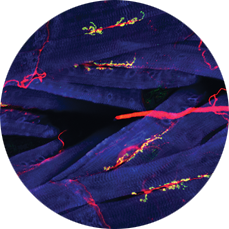
The mission and vision of the Cell Regulation and Development Affinity Group is to increase fundamental knowledge of basic molecular mechanisms of cell biology and animal development and enhance understanding of how dysregulation of these processes contributes to human disability and disease.
By combining expertise in the genetics of model organisms (including yeast, fruit fly, frog, zebrafish, and mouse), cell biology, biochemistry, molecular biology, electrophysiology, biophysics, genomics, and structural biology, members of the Group advance individual research objectives by regularly providing insights and advice to one another and through collaborations enabling synergy in research methods and experimental approaches. These interactions have engendered the development of novel technologies and strategies that underlie past accomplishments and will facilitate future discoveries by the Group in areas including the mechanisms and regulation of protein synthesis and transcriptional activation of gene expression, the functions and regulation of hormone receptors, signaling events and their responsive genes, mechanisms governing accurate segregation of the genetic information during cell division, mechanisms of nucleocytoplasmic trafficking, RNA processing and RNA export, technologies based on transposable elements and deep sequencing for genome-wide profiles of gene function, the role of transposable elements in reorganizing the host genome in response to stress, technologies for analyzing gene expression at the single cell level during development, transcriptional control of the specification and differentiation of cells during vertebrate embryogenesis, the mechanisms governing adult organ formation during postembryonic vertebrate development, and molecular mechanisms of synaptic circuit assembly and function.
Labs within this group include (alphabetically):
- Mary Dasso Lab: Section on Cell Cycle Regulation
- Tom Dever Lab: Section on Protein Biosynthesis
- Jeffrey Farrell Lab: Unit on Cell Specification and Differentiation
- Alan Hinnebusch Lab: Section on Nutrient Control of Gene Expression
- Henry Levin Lab: Section on Eukaryotic Transposable Elements
- Jon Lorsch Lab (NIGMS): Laboratory on the Mechanism and Regulation of Protein Synthesis
- Mihaela Serpe Lab: Section on Cellular Communication
- Yun-Bo Shi Lab: Section on Molecular Morphogenesis

 BACK TO TOP
BACK TO TOP